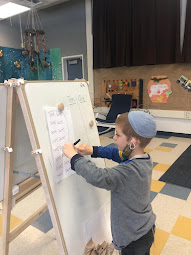Math
This month we learned how to make groups of ten.
We learned this by using different manipulatives as concrete examples .
Bristle blocks is a great visual to group ten since they can build a stack.
Mendel, double checking his work by counting what he built.
Mina, making a bundle of ten straws.
Tooth picks was another fun way we invited our friends to make multiple bundles of ten. Using small ponytails was a challenging way to use our fine motor skills to wrap these small items together.
Q-tip scavenger hunt to make bundles of ten.
Abstract to concrete
Once we got good practice making groups of ten, it was now time to introduce a higher number and count how many tens and how many ones left over to figure out the sum total.
The orange pipe cleaner was used to make the bundle of ten and the yellow one was for the group of beads that would be the ones.
Our friends wrote down the number they created. The abstract math skill was now becoming very concrete using this method of building, creating, then writing the number.
Friends were invited up to create a group of ten on the white board, and count the ones left over. Transferring the concrete number to the written number is an important exercise to help the children understand the value of the written number.Practicing writing our numbers.
English
We have officially begun the Capit Reading Program!
CAPIT Reading is an explicit and systematic Phonics Curriculum covering the foundational skills necessary for fluent reading and accurate spelling. What is unique about Capit, is that in addition to the teacher offering in person introduction to the sounds of each letter, the children must demonstrate their understanding of the sounds they have learned through an app on an Ipad.
The curriculum is designed to not allow the child to move forward in the curriculum without displaying a complete knowledge of the sounds that have already been introduced. Each step of the curriculum builds on the previous step, ensuring no child falls behind!
The app's assistance in picking up the child's understanding of each sound is critical for a child to progress in blending words and succeeding in their reading.
Research and experience indicate that Visual Mnemonics are an efficient and fun method of helping students remember the relationship between the sound of a letter and its visual representation. CAPIT Reading provides unique Visual Mnemonics for every letter in the English language.
We invite you to get a glimpse of the fun ;)
Moshe learning the image the letter O looks like. We are constantly asking our friends when they are unsure of what a letter is, "what does it look like?" This helps them remember and retain the sound.
Mendel, using his artistic abilities to make his letter.
Mendel P already putting together words by sounding out where the letters go. Its a self correcting way to learn how to spell since if its the wrong letter it bounces right out!

















No comments:
Post a Comment